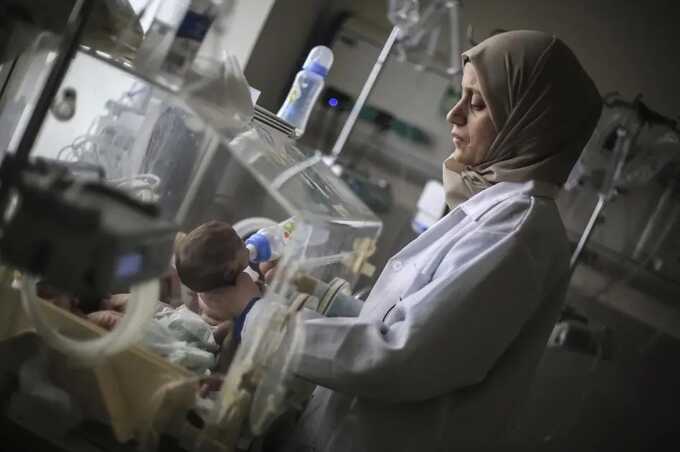Critically ill children leave Gaza through Kerem Shalom crossing
Sixty-eight minors, five with cancer, allowed to enter Israel before travelling to Egypt and elsewhere for treatment
A group of critically ill children have been allowed to leave Gaza, the first such medical evacuation since early May when Israel seized control of Rafah, the territory’s sole border crossing with the outside world.
Sixty-eight minors, including five who have cancer, were allowed to travel through the Kerem Shalom crossing into Israel on Thursday, and were to travel to Egypt and further abroad for medical treatment.
It was not immediately clear where the children, most of whom were escorted by one relative, would be treated. Many of the guardians cried as the patients were transferred on Thursday morning from Nasser hospital in Khan Younis.
Kamela Abuweik, who was not allowed to travel with her son, meaning he had to be accompanied by his grandmother instead, told the AP news agency: “He has tumours spread all over his body and we don’t know what the reason is. And he constantly has a fever. I still don’t know where he is going.”
The World Health Organization’s regional director for the eastern Mediterranean, Hanan Balkhy, welcomed news of the evacuation, but noted: “More than 10,000 patients still require medical care outside the Strip. Of the 13,872 people who have applied for medical evacuation since 7 October, only 35% have been evacuated.”
“Medical evacuation corridors must be urgently established for the sustained, organized, safe, and timely passage of critically ill patients from Gaza via all possible routes,” she wrote on X.
Egypt has refused to reopen the Rafah border crossing, the only way out of the territory for fleeing civilians and the major channel for aid, since Israeli forces captured it at the start of their ground operation in the area last month. Cairo officials have maintained that the crossing – since the war broke out, the sole one for civilians leaving the territory – must be returned to Palestinian control.
After nine months of conflict, Israeli airstrikes and ground fighting with Hamas have devastated Gaza’s medical facilities and more than 25,000 people are now in need of treatment abroad, Dr Mohammed Zaqout, the head of the area’s hospitals, said in a media conference on Thursday.
The Rafah closure has also severely affected the delivery of food, medicine and other aid: a UN report released this week found that a fifth of the strip’s 2.3 million population were still at high risk of famine. Israel denies it has created famine conditions, instead blaming relief agencies for distribution problems and accusing Hamas of diverting aid.
Fierce fighting and airstrikes continued in central Rafah and restarted in the Gaza City neighbourhood of Shejaiya on Thursday, residents reported. According to medics and the civil defence agency in the Hamas-run territory, Israeli strikes overnight and early Thursday killed at least five people in Gaza City and another in Beit Lahia, also in the north. The Israeli military said it had “attacked terrorists who were in a school complex in Khan Younis” in the south.
The flare-up in northern Gaza occurred despite comments last week from Benjamin Netanyahu, Israel’s prime minister, that the “intense phase” of the war, sparked by 7 October Hamas attacks, was winding down, and amid fears of escalation between Israel and the Lebanese militia Hezbollah.
Hezbollah began attacking Israel on 8 October in an effort to aid its ally Hamas, and tit-for-tat aerial attacks have intensified in recent weeks. Israel’s defence minister, Yoav Gallant, said on Wednesday that “we do not want war, but we are preparing for every scenario”, adding that an all-out conflict would send Lebanon “back to the stone age”.
Israel has started to deploy extra troops to its northern border in preparation for potential full-scale war, and officials said last week that plans for a ground offensive in Lebanon to drive the Iran-backed Shia militia away from the border region had been signed off, prompting fierce threats from the group’s leader, Hassan Nasrallah.
Anti-government demonstrators held a day of protests across Israel on Thursday, blocking motorways and gathering outside politicians’ homes to demand a hostage deal and new elections.
About 1,200 Israelis, mostly civilians, were killed by Hamas on 7 October and another 250 taken hostage, according to Israeli figures. The ensuing Israeli operation in Gaza has killed almost 38,000 people, according to the local health ministry, which does not distinguish between civilian and military casualties.
Under a ceasefire deal in November, 100 hostages were released in exchange for hundreds of Palestinians held in Israeli jails, but the deal collapsed after a week. Repeated attempts by the US, Qatar and Egypt to broker a second truce have failed.
It is widely believed in Israel that Netanyahu is stalling on a deal and bringing the Gaza war to an end in an effort to stay in office, which he is understood to see as the best chance of evading prosecution on corruption charges that he denies.
Read more similar news:
Comments:
comments powered by Disqus


































